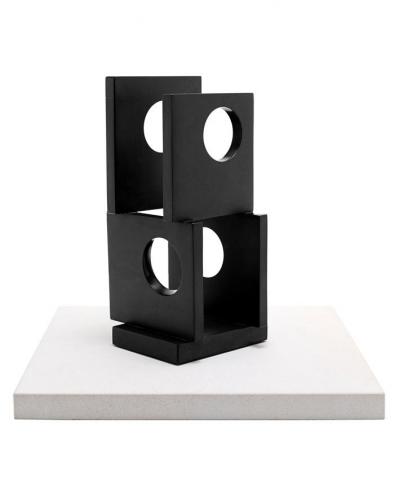MAQUETTE FOR LARGE SCULPTURE: FOUR-SQUARE (FOUR CIRCLES), 1966
BARBARA HEPWORTH
slate
28.0 cm height
John Crowther OBE, Truro, United Kingdom, a gift from the artist in 1966
David Lay Auctions, Cornwall, United Kingdom, 30 July 2009, lot 534
Peter Nahum at The Leicester Galleries, London
Private collection, Sydney
Barbara Hepworth, Gimpel Fils, London, May – June, 1966, cat. 31 (another example)
Bowness, A. (ed.), The Complete Sculpture of Barbara Hepworth 1960–69, Lund Humphries, London, 1971, cat. 407, pl. 145 (illus.)
Curtis, P., and Wilkinson, A., Barbara Hepworth: A Retrospective, Tate Gallery Publications, London, 1994, pp. 106–107 (illus. related works)
Four-Square (Four Circles), 1966, slate, 60 cm height, in Bowness, A., The Complete Sculpture of Barbara Hepworth 1960–69, Lund Humphries, London, 1971, cat. 416, pl. 142 (illus.)
Four-Square (Four Circles), 1966, bronze, 60 cm height, edition of 7, in Bowness, A., The Complete Sculpture of Barbara Hepworth 1960–69, Lund Humphries, London, 1971, cat. 428
Four-Square (Walk Through), 1966, bronze, 429 cm height, edition of 3, in Bowness, A., The Complete Sculpture of Barbara Hepworth 1960–69, Lund Humphries, London, 1971, cat. 433
We are grateful to Dr Sophie Bowness of the Hepworth Estate for her assistance cataloguing this work.
'It is the first time in my life that I have achieved an idea, so exact, that it could be carried out posthumously, at full scale - i.e. to enter - if ever a site could be found.'1
A site was found: in fact, the monumental version of this work, Four-Square (Walk Through), 1966, was cast in an edition of three and installed in the grounds of Churchill College, Cambridge, United Kingdom; Norton Simon Museum, Pasadena, United States of America; and the Barbara Hepworth Museum and Sculpture Garden, Cornwall, United Kingdom. At over four metres in height, the work is a celebrated example of Hepworth's abstract forms that explore architecture, light and human interaction.
Four-Square (Walk Through), 1966 was Hepworth's first work which allowed people to walk through the sculpture, fulfilling her desire to physically engage the viewer: 'I wanted to involve people, make them reach to the surfaces and the size, finding out which spiral goes which way, realising the differences between the parts'.2 Previously restricted by the limitations of working with carved stone, Hepworth began to use bronze as it allowed her to experiment with size, scale and cast editions.
The large bronze slabs of Four-Square (Walk Through) overawe the senses as the sculpture envelops the viewer and shadows cast by the circular apertures illuminate the form in either sunlight or starlight. The imposing assemblage is reminiscent of the ancient stones that punctuate the English countryside and like Stonehenge, which is simultaneously foreign against the landscape yet deeply rooted to the earth, Four-Square (Walk Through) adheres to and questions the surrounding environment.
Maquette for Large Sculpture: Four-Square (Four Circles), 1966 is a rare and significant work from Hepworth's oeuvre, allowing us to closely study the model for Four-Square (Walk Through). Although it has been claimed that Hepworth never worked from a smaller maquette, there are three small scale versions of Four-Square (Walk Through), including the sculpture on offer.3 This provides an exceptional insight into Hepworth's practice, 'the size of the slate maquettes ... which Mullins called 'table-sized' - suggests a process of scaling-up. Both of the maquettes establish some of the fundamental relationships of form. This included the rectangular form of the elements, the slippage between those of each pair - so that they project over the base to different extents - and the notable difference in height in the upper air.'4 Although smaller in size than its larger counterpart, Maquette for Large Sculpture: Four-Square (Four Circles) embodies all of the same ideological elements and notions of form and scale, imperative to Hepworth's art.
The 1960s was an exceptionally successful period for Hepworth. Acknowledged as the world's greatest female sculptor, she was awarded honorary degrees by the universities of Birmingham in 1960, Leeds in 1961, Exeter in 1966 and Oxford in 1968 among others, and held major exhibitions internationally. Yet despite the widespread success and public recognition during these later years, Hepworth faced a private struggle as she was diagnosed with cancer in 1965. Confronted with mortality, the topic of death pervades Hepworth's work in the ensuing years and was a strong factor in the monumental size of Four-Square (Walk Through). 'Yes of course it was [related]. It was the same in 1938. If war was imminent, or you're very ill or something's threatening, you want to put something down for big work while you can. I was in an absolute fever of ideas, without much hope of fulfilment.'5 Perhaps this desire to fulfil the image of Four-Square (Walk Through) led Hepworth to create these extraordinary maquettes, in an effort to achieve perfection in an otherwise turbulent and bittersweet period of her life. Hepworth's Maquette for Large Sculpture: Four-Square (Four Circles) is at one with humanity and nature, as the artist herself describes, 'I cannot write anything about landscape without writing about the human figure and human spirit inhabiting the landscape. For me, the whole art of sculpture is the fusion of these two elements - the balance of sensation and evocation of man in this universe.'6
1. The artist in a letter to the original owner, John Crowther, dated 22 February 1966
2. Wilkinson, A., 'Cornwall and the Sculpture of Landscape: 1939 - 1975' in Curtis, P., and Wilkinson, A., Barbara Hepworth: A Retrospective, Tate Gallery Publications, London, 1994, p. 108
3. Gale, M.,'Four-Square (Walk Through), 1966', Tate, London, 1998, <http://www.tate.org.uk/art/artworks/hepworth-four-square-walk-through-I0...
4. Ibid.
5. Hepworth, B., cited in Bowness, A. (ed.), The Complete Sculpture of Barbara Hepworth 1960-69, Lund Humphries, London, 1971, p. 12
6. Hepworth, B., cited in Wilkinson, A., 'Cornwall and the Sculpture of Landscape: 1939-1975', op. cit., p. 108
CASSI YOUNG
